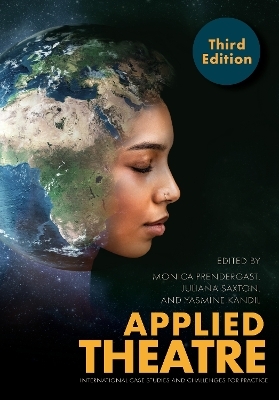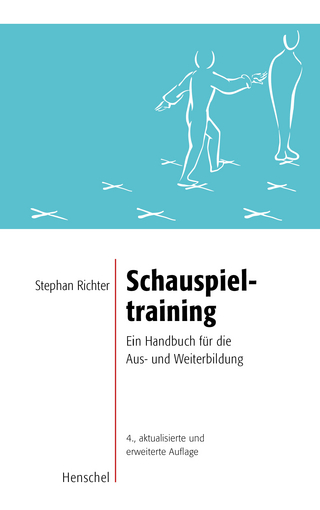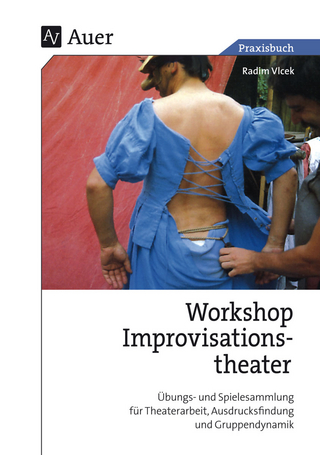
Applied Theatre, Third Edition
Intellect Books (Verlag)
978-1-78938-922-7 (ISBN)
Applied Theatre was the first collection to assist practitioners and students in developing critical frameworks for their own community-based theatrical projects. The editors draw on thirty case studies in applied theatre from fifteen countries—covering a wide range of disciplines, from theatre studies to education, medicine, and law—and collect essential readings to provide a comprehensive survey of the field.
Infused with a historical and theoretical overview of practical theatre, Applied Theatre offers clear developmental approaches and models for practical application.
This third edition offers refreshed case studies from many countries worldwide that provide exemplars for the practice of applied theatre. The book will be useful to both instructors and students, in its focus on providing clear introductory chapters that lay out the scope of the field, dozens of case studies in all areas of the field, and a new chapter on responses to the global pandemic of 2020.
Also includes a new section on representation in its final chapter, looking at the issues of how we represent ourselves and others on stage.
Dr. Monica Prendergast is Professor of Drama/Theatre Education at the University of Victoria, BC, Canada. Professor Emeritus Juliana Saxton taught drama/theatre education in the Theatre Department at the University of Victoria. She remains active in peer reviewing and publishing and has been the recipient of many awards. Dr. Yasmine Kandil is Associate Professor of Applied Theatre at the University of Victoria.
Acknowledgements
Preface: What is this book about?
Part One: Theories, History and Practices of Applied Theatre
Chapter One: Theories and History of Applied Theatre
1.1 What does applied theatre look like?
1.2 What is applied theatre?
1.3 Why applied theatre?
1.4 How did applied theatre emerge?
1.5 Further history of the field
1.6 What is the socially engaged purpose of applied theatre?
Summary
Further reading
Questions for reflection and discussion
Suggested activities
Chapter Two: Practices of Applied Theatre
2.1 How do we make applied theatre?
2.2 Who are the performers of applied theatre?
2.3 Who is applied theatre for?
2.4 What are the four main intentions in applied theatre?
2.5 How is applied theatre funded?
2.6 How do we assess applied theatre?
2.7 How might we reflect on applied theatre practice?
Summary
Further reading
Questions for reflection and discussion
Suggested activities
Chapter Three: Story, Storytelling and Applied Theatre
3.1 How is story related to applied theatre?
3.2 What kinds of stories inform applied theatre?
3.3 What is effective storytelling?
3.4 How does storytelling change in applied theatre?
3.5 What are the issues around the uses of story in applied theatre?
Summary
Further reading
Questions for reflection and discussion
Suggested activities
Part Two: The Landscape of Applied Theatre
Chapter Four: Popular Theatre
4.1 Introduction
4.2 Popular theatre as spectacle from Shank, T. (1977). The Welfare State Theatre. TDR: The Drama Review, 21(1)
4.3 Puppetry with at-risk youth from Donelan, K., & O’Brien, A. (2006). Walking in both worlds: Snuff Puppets at Barak Indigenous College. ATR: Applied Theatre Researcher, 7(2)
4.4 Extending an ‘ethics of care’ to the ‘other’ from Wang, W.-J. (2010) Transgressive local act: Tackling domestic violence with forum and popular theatre in Sisterhood bound as Yuan Ze Flowers, Research in Drama Education: The Journal of Applied Theatre and Performance, 15(3)
4.5 Popular theatre in Urban Senegal from Valente-Quinn, B. (2020). Crafting the popular stage space in urban Senegal. Research in African Literatures, 51 (1)
Further reading
Questions for reflection and discussion
Suggested activities
Web resources
Chapter Five: Documentary Theatre
5.1 Introduction
5.2 Fight for freedom from Niemi, I. (1973). Peter Weiss and documentary theatre: Song of a scarecrow. Modern Drama, 16(1)
5.3 Provoking empathy from Baer, P., Salisbury, J., & Goldstein, T. (2019). Pairing verbatim theatre and theatre of the oppressed to provoke startling empathy, The Educational Forum, 83(4)
5.4 Reciprocating roles from Stuart Fisher, A. (2011). ‘That’s who I’d be if I could sing’: Reflections on a verbatim project with mothers of sexually abused children. Studies in Theatre and Performance, 31(2)
5.5 Detaining asylum seekers in Australia from Wake, C. (2013). To witness mimesis: The politics, ethics, and aesthetics of testimonial theatre in Through the Wire. Modern Drama, 56(1)
Further reading
Questions for reflection and discussion
Suggested activities
Web resources
Chapter Six: Theatre in Education (TIE)
6.1 Introduction
6.2 Human rights from Dukes TIE Company. (1993). Indigo. SCYPT Journal, 26
6.3 Disability and the inclusive classroom from Kim, B.-J. (2009). A journey of change with a Big Blue Whale: A theatre-in-education (TIE) programme on disability and dilemmas in the inclusive classroom in Korea. RIDE: The Journal of Applied Theatre and Performance, 14(1)
6.4 Countering radicalization from Piasecka, S. (2019). Performing PREVENT: Anti-extremist theatre-in-education in the service of UK counter-terrorism, a Freirean analysis, Critical Studies on Terrorism, 12(4)
Further reading
Questions for reflection and discussion
Suggested activities
Web resources
Chapter Seven: Theatre of the Oppressed (TO)
7.1 Introduction
7.2 A letter from Augusto Boal from Schechner, R., Chatterjee, S., & Boal, A. (1998). INTERVIEW: Augusto Boal, city councillor: Legislative theatre and the chamber in the street. TDR: The Drama Review, 42(4)
7.3 Forum theatre on sexual harassment from Dwyer, P. (2004). Making bodies talk in forum theatre. RIDE: Research in Drama Education, 9(2)
7.4 Changing Attitudes on Child Trafficking in West Bengal from Brahma, J., Pavarala, V., & Belavadi, V. (2019). Driving social change through forum theatre: A study of Jana Sanskriti in West Bengal, India. Asia Pacific Media Educator, 29(2)
7.5 Queer Shakespeare in Majorca from de Castro, J. B., Berbel, N., & Jaume, M. (2022). ‘Your luxury loft, my daily misery!’ University theatre, neighbours, and schools combat gentrification through applied theatre practices in a marginal district of Majorca, Spain. Research in Drama Education: The Journal of Applied Theatre and Performance, 27(1)
Further Reading
Questions for reflection and discussion
Suggested activities
Web Resources
Part Three: The Locations of Applied Theatre
Chapter Eight: Theatre in Health Education (THE)
8.1 Introduction
8.2 HIV/AIDS from Dugga, V. S. (2002). Icons and metaphors in African theatre against HIV/AIDS. NJ: Drama Australia Journal, 26(2)
8.3 Prenatal screening as multimedia performance from Hundt, G.L., Bryanston, C., Lowe, P., Cross, S., Sandall, J., & Spencer, K. (2010). Inside ‘Inside View’: Reflections on stimulating debate and engagement through a multimedia live theatre production on the dilemmas and issues of pre-natal screening policy and practice. Health Expectations, 14
8.4 From stigma to empathy from Senior, K., Grazdanovski, L., Chenhall, R., & Minton, S. (2018). ‘Our Lives’ and ‘Life Happens’, from stigma to empathy in young people’s depictions of sexual health and relationships. Journal of Applied Arts & Health, 9(1)
8.5 Performative strategies for deconstructing politics of the body from Chinyowa, K. C., & Chivandikwa, N. (2017). Subverting ableist discourses as an exercise in precarity: A Zimbabwean case study. RIDE: the Journal of Applied Theatre and Performance 22(1)
Further reading
Questions for reflection and discussion
Suggested activities
Web resources
Chapter Nine: Theatre for Development (TfD)
9.1 Introduction
9.2 Theatre-making with Cairo’s Young Garbage Pickers from Kandil, Y. (2015). Theatre for development in the slums of Cairo: The impact on a disempowered community. Applied Theatre Research, 3(2), 237–250.
9.3 A Bangladesh TfD project from Ahsan, N. (2004). Social theatre in Bangladesh. TDR: The Drama Review, 48(3)
9.4 Women’s rights in Pakistan from Mundrawala, A. (2007). Fitting the bill: Commissioned theatre projects on human rights in Pakistan: The work of Karachi-based theatre group Tehrik e Niswan. RIDE: Research in Drama Education, 12(2)
9.5 Environmental theatre project from Chukwu-Okoronkwo, S. O. (2020). Re-enacting theatre for development. The Journal of Development Communication, 31(1)
Further reading
Questions for reflection and discussion
Suggested activities
Web resources
Chapter Ten: Prison Theatre
10.1 Introduction
10.2 Fatherhood and family from Mitchell, T. (2001). Notes from inside: Forum theatre in maximum security. Theater, 31(3)
10.3 Excavating history from Prendergast, M. (2016). Tracing the journey to here: Reflections on a prison theatre devised project. Theatre Topics, 26(3)
10.4 Death and dreams from Wilson, J. (2013). Agency through collective creation and performance: Empowering incarcerated women on and off stage. Making Connections: Interdisciplinary Approaches to Cultural Diversity, 14(1)
Further reading
Questions for reflection and discussion
Suggested activities
Web resources
Chapter Eleven: Community-Based Theatre
11.1 Introduction
11.2 Large-scale community play from Horitz, T. (2001). ‘B-O-U-R-N-E-M-O-U-T-H! Our Town!’ Effects on male teenagers of participation in a community play. RIDE: Research in Drama Education, 6(1)
11.3 Threats to the family farm from Ming T’ien Duffly, C. (2016, November). Theatre Topics, 26(3)
11.4 Challenging the patriarchy from El-Dirani, Z., Akik, C., Attel, L., Kamhawi, R., Nawafleh, M., Essaid, A., & DeJong, J. (2022). Interactive community-based theatre to address social barriers to accessing reproductive health services in patriarchal societies: The case of Jordan. Culture, Health & Sexuality, https://doi.org/10.1080/13691058.2022.2029572
11.5 Dreams over reality from Liang, S. (2014). Performing dream or reality: The dilemma of Chinese community-based theatre. TDR: The Drama Review, 58(1)
Further reading
Questions for reflection and discussion
Suggested activities
Web resources
Chapter Twelve: Museum Theatre
12.1 Introduction
12.2 In the present looking at the past from Williams, P. (2013). Performing interpretation. Scandinavian Journal of Hospitality and Tourism, 13(2)
12.3 Re-examining history through museum theatre from Magelssen, S. (2006). Making history in the second person: Post-touristic considerations for living historical interpretation. Theatre Journal, 58(2)
12.4 Critical engagement through a city ‘performance walk’ from Nikonanou, N. & Venieri, F. (2017). Interpreting social issues: Museum theatre’s potential for critical engagement. Museum & Society, 15(1)
Further reading
Questions for reflection and discussion
Suggested activities
Web resources
Chapter Thirteen: Reminiscence Theatre
13.1 Introduction
13.2 Memory and transgression from Wang, W.-J. (2006). The subversive practices of reminiscence theatre in Taiwan. RIDE: Research in Drama Education, 11(1)
13.3 Intergenerational reminiscence theatre from Petherbridge, J. & Kendall, D. (2012). The process and impact of intergenerational theatre making. Quality in Ageing and Older Adults, 13(4)
13.4 Uncharted territory of widowhood from Feldman, S., Hopgood, A., & Dickens, M. (2013). Translating research findings into community based theatre: More than a dead man’s wife. Journal of Aging Studies, 27
13.5 Recalling a past long forgotten from Haki, A. J. (2020). Detroit 1967 Riot, applied theatre and older adults. Teaching Artist Journal, 18(3–4)
Further reading
Questions for reflection and discussion
Suggested activities
Web resources
Chapter Fourteen: Pandemic Response
14.1 Introduction
14.2 From stage to screen from Pufahl, J., Crider, E., & Walker, K. (2021). Exploring online participatory theatre during COVID-19: Reflections on adapting, delivering, and evaluating student-led theatre for health workshops. Pedagogy and Theatre of the Oppressed Journal, 6(1).
14.3 Sonic engagement with women inside from Vachon, W. & Woodland, S. (2021). Finding resonance: Applied audio drama, inquiry and fictionalising the real. Research in Drama Education: The Journal of Applied Theatre and Performance, 26(4).
14.4 Social distance and mental health from Hunt, A., & Wooster, R. (2021). Social distancing without emotional distancing? Journal of Applied Arts & Health, 12(3).
Further reading
Questions for reflection and discussion
Suggested activities
Web resources
Part Four: Challenges for Practice
Chapter Fifteen: Participation, Representation, Aesthetics, Ethics and Assessment
15.1 Participation
15.2 Representation
15.3 Ethics
15.4 Artistry and aesthetics
15.5 Assessment/evaluation
15.6 Summary
Further reading
Questions for reflection and discussion
Suggested activities
Afterword: Reflection
Bibliography
Index
| Erscheinungsdatum | 21.09.2023 |
|---|---|
| Zusatzinfo | No artwork |
| Sprache | englisch |
| Maße | 170 x 244 mm |
| Themenwelt | Kunst / Musik / Theater ► Theater / Ballett |
| ISBN-10 | 1-78938-922-4 / 1789389224 |
| ISBN-13 | 978-1-78938-922-7 / 9781789389227 |
| Zustand | Neuware |
| Informationen gemäß Produktsicherheitsverordnung (GPSR) | |
| Haben Sie eine Frage zum Produkt? |
aus dem Bereich


